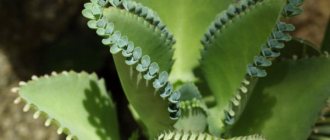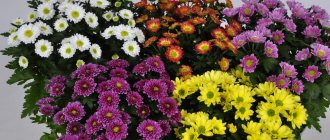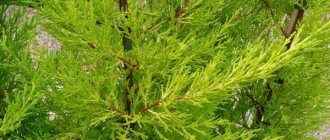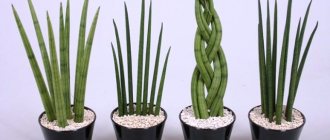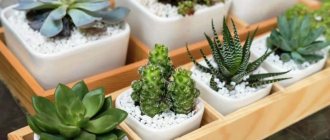Numerous representatives of the Crassulaceae family, numbering more than two hundred species, are very often found on home windowsills. These persistent succulent plants migrated from the hot southern tropics of America, Africa and Asia, but managed to perfectly adapt and even bloom in difficult indoor conditions.
The unpretentious Kalanchoe Blossfeld, blooming most of the year, looks great in almost any interior.
But it does not always please its owners with colorful colors; in some cases, the plant flatly refuses to set buds. It is not at all difficult to achieve lush and long-lasting flowering from a home succulent; you just need to provide suitable conditions for this.
Botanical description
Kalanchoe is a genus of leafy succulents consisting of 200 perennial species. Belongs to the Crassulaceae family.
The area is quite extensive:
- South America;
- Africa;
- Madagascar island;
- south of Asia.
Among those capable of beautifully blooming, upright ones are Kalanchoe Fedchenko, Blossfeld and its hybrids. Mangina is a typical ampel.
Stems for all types:
- juicy;
- fragile;
- herbaceous;
- For good branching they require pinching.
The shape and size of the leaves depend on the species. But the plates of Kalanchoe in nature are designed to store moisture reserves, which are consumed during the dry period, in the taxa listed above:
- thick;
- fleshy;
- juicy;
- with a shiny, smooth epidermis that does not allow moisture to be lost under exposure to sunlight or in the heat.
Spraying
In general, there is no need to spray Kalanchoe, since the plant feels quite normal without it. However, in hot summer weather this procedure can be performed. This will only make the plant better. The need for spraying is explained by the fact that this flower has fleshy, sometimes pubescent, leaves from which moisture evaporates rather slowly.
Flowering period and characteristics
The culture has bell-shaped, four-petalled corollas that “look”:
- up - in the Blossfeld species, varieties and hybrids;
- droop and point downward when Kalanchoe Fedchenko and Mangina bloom.
This is largely due to the fact that in the first species the buds are collected in baskets and sit on very short, strong stems. The remaining two Kalanchoes form loose panicles with long thin peduncles on which bells are “suspended.”
Species plants produce simple corollas; more popular hybrids will bloom with double roses. The first Kalandiva had 32 petals, instead of 4. There is no available data on how many there are now, but judging by their appearance, there are varieties with more or less “stuffed” corollas.
The color of Kalanchoe is varied. Represented by almost the entire spectrum, except:
- blue;
- blue.
Kalanchoe species may bloom once a year. Varieties and hybrids are capable of producing new buds intermittently several times a season. But Kalanchoe is a short-day plant. To bloom, it needs to create special conditions. The following help stimulate the formation of generative buds:
- rest period;
- transfer;
- pruning;
- cool winter;
- short daylight hours and long nights.
The flowering time of Kalanchoe depends on the species:
- Mangina and Fedchenko bloom in the spring;
- Blossfeld - from mid-winter to May.
The most popular variety series Kalandiva can be made to bloom at any time using special techniques. Including blooming the buds by a certain date.
The duration of Kalanchoe flowering at home depends on the temperature. The warmer the room, the faster the corollas fade. To prolong the peak of decorativeness, coolness is needed, despite the fact that this is a succulent.
The fruits are clustered leaflets with very small seeds. Hybrids rarely form; planting material must be purchased for propagation.
Watering
You need to water the flower moderately. Kalanchoe are succulent plants that accumulate moisture and do not require abundant and frequent soil moisture.
Excess moisture is very harmful to succulents.
In summer, Kalanchoe is rarely watered, no more than once a week. In winter, when the plant is kept cool, watering is significantly reduced.
At any time of the year, Kalanchoe is watered only after the top layer of soil has dried 3-4 cm.
The plant is adapted to dry climates; spraying for moisture is not required. To remove dust from the leaves, the flower can be washed in the shower, but this is done no more than once a season and only in the summer. In this case, water should not get into the soil.
Types of flowering Kalanchoe
Kalanchoe of all types blooms, but only some can call the blossoming corollas decorative. Most representatives of the genus are decorative foliage or medicinal indoor plants.
Blossfeld
Kalanchoe blossfeldiana is the most common and popular species. The shoots are erect, about 30 cm high. They branch well.
Leaves:
- ovoid;
- with rounded teeth along the edge;
- dark green;
- maximum size 7x4 cm.
The flowering period of Kalanchoe Blossfeld is from February to May. The corollas are simple, in the species plant they are red, collected in loose umbrellas. Varieties of various colors.
Kalandiva
The most popular series with densely double corollas reminiscent of roses. Previously, the buds bloomed in winter. Modern hybrids can bloom with proper care at home all year round with breaks of 1.5-2 months.
It is distinguished by rounded petals of various colors. The height of the bushes is about 25-30 cm; within the series there are mini varieties up to 15 cm tall.
Rosaline
Another variety series Kalanchoe blossfeldiana. It also prefers to bloom in the cold season, with double petals, but not rounded, but pointed. Grows up to 25 cm.
Mangina
Kalanchoe manginii - Kalanchoe blooms from late spring. The species is a hanging plant with drooping shoots, small, bright green, oval leaves.
Corollas:
- hang on long thin peduncles;
- collected in loose brushes;
- large;
- elongated;
- campanulate;
- can bloom yellow, pink, orange, crimson, purple;
- The coloring of the corollas is often combined.
The Mangina species is often called the African bluebell.
Fedchenko
Kalanchoe fedtschenkoi is a rather rare plant in cultivation. Kalanchoe blooms at home in spring.
Tubular beaters:
- orange or apricot shades;
- covered with pearly sepals;
- collected in sparse clusters;
- hanging on long, curved stalks.
The plant is erect, the shoots branch well, the internodes are short. Leaves:
- obovate;
- dove-blue;
- often with pink, white, purple markings or borders;
- the tip of the plate is serrated.
Fertilizer, top dressing
Kalanchoe does not really like various fertilizers. Just like in the matter of soil, the plant is quite unpretentious, but if you begin to notice that the flower lacks minerals, then choose succulent fertilizers. In winter, you should never fertilize the soil.
During this period, even if the Kalanchoe begins to wither (except for diseases), you should not overload the root system with various additives. The best time for feeding is the end of spring, or at least mid-summer. Fertilizers should be given half as much as indicated on the package - believe me, this amount will be more than enough for your home healer.
The only important rule when fertilizing is that the fertilizer mixture must be completely dissolved in warm water, then allow it to cool and only then add it to the soil. Otherwise, the root system will not be able to absorb the fertilizer.
KALANCHOE - HOME DOCTOR
Until the 60s of the last century in Europe there was practically no information about the medicinal properties of Kalanchoe, but as it began to enter indoor culture, reports of its medicinal properties began to appear. Thus, it was noted, for example, that by lubricating the nasal mucosa, the flu was quickly cured, and during the epidemic, people used it as a preventive measure. The juice of mashed Kalanchoe leaves stopped bleeding, quickly relieved toothache and headaches, and cured mastitis, eczema, and skin rashes. As a result of such reports, official medicine began to study this unusual plant. By the end of the 1960s, it was introduced into pharmacological practice as a treatment for long-term non-healing wounds and ulcers, fistulas and burns. True, it is worth noting that official medicine has focused only on the external use of plant juice, which cannot be said about traditional medicine.
It is not for nothing that this plant has received the status of the tree of life among the people. Kalanchoe juice has a pronounced anti-inflammatory, bactericidal, wound-healing, hemostatic effect, therefore it is used in the healing of ulcers, bedsores, wounds, burns, frostbite. Fresh Kalanchoe juice stops bleeding, treats boils, skin rashes, eczema, burns, cervical erosion, and cracked nipples. It not only destroys bacterial infection, but also exhibits antiviral activity. This juice is also effective for tonsillitis, periodontal disease, stomatitis..
Home care
All species grown for flowering require approximately the same maintenance. Even beginners can care for plants so that the bush is beautiful. But not everyone can ensure that the crop begins to bloom for a long time or repeatedly, although this is also not difficult.
Lighting and temperature
All Kalanchoes are short-day plants. Some people misunderstand this, confusing it with shade tolerance, place the pot on a north or north-west window, and believe that they have provided the crop with comfortable conditions. And then they wonder why the bush stretches out and refuses to put out buds.
In fact, in order to bloom and grow normally, Kalanchoe needs:
- intense sun (artificial light) for at least 4, maximum 10 hours a day, preferably 8-9;
- the rest of the time what is needed is not partial shade or poor lighting, but a long night lasting more than 12 hours.
In winter, in order for Kalanchoe to bloom, you will have to provide bright lighting for at least 4 hours a day. During the cold season there is little sun, its intensity is low.
Despite the fact that Kalanchoe is a succulent, the plant likes cool weather. It will bloom even at a temperature of 28°C, but not for long. It is better that the thermometer does not rise above 20° C, and the longest flowering is observed at 15-16° C. During the dormant period, which in Kalanchoe, depending on the species, lasts from 1.5-2 to 3-4 months, the temperature should be even lower. Otherwise it will not bloom.
Kalanchoe Mangina, Fedchenko, species plant and all varieties of Blossfeld, except Kalandiva, require 10-14 ° C during rest. The temperature can rise to 16 ° C only for a short time.
In order to bloom normally, Calandiva is content with 16° C during the dormant period. Moreover, sometimes the thermometer can show 18° C.
Humidity and watering
Kalanchoe should be watered carefully, especially flowering species:
- in Kalanchoe blossfeldiana and K. fedtschenkoi, due to short internodes and low-lying leaves, it is not always possible to notice softening of the stem or acidifying soil;
- The situation is even worse with K. manginii, which hangs its shoots down and forms a thick cap of leaves above the pot.
If the weather is sunny and hot, the substrate should dry out 1/3 between waterings of the Kalanchoe. During the dormant period or at low temperatures, when Kalanchoe blossfeldiana begins to bloom, its varieties and hybrids - 2/3.
It is impossible to say how many times a week to irrigate. It all depends on many factors:
- room temperature;
- air humidity;
- illumination;
- material, pot capacity;
- substrate;
- volume of the root system;
- the size and intensity of growth of the bush;
- for a flowering plant - the number of buds.
Regarding Kalanchoe, beginners can be given advice that is not applicable to most potted crops. It is better to water more often, but little by little, to prevent the soil from becoming waterlogged.
Air humidity does not play a significant role. Until the bush begins to bloom, the dust can be washed off by periodically spraying the leaves. But only at temperatures above 20° C, otherwise the vegetative organs will begin to rot. After the buds emerge, wipe the large leaves with a clean, damp cloth.
Feeding
Caring for flowering Kalanchoe involves applying fertilizers:
- if you use preparations for cacti, you need to follow the instructions;
- When using fertilizers for beautiful flowering plants, you need to dilute them 2 times more than recommended in the description, give them every 2 weeks.
During rest, plants are not fertilized, especially since they are replanted, and the finished substrate contains nutrients. The first time to feed Kalanchoe after a period of dormancy is when the bush is about to bloom - it begins to put out buds.
In summer, the plant may not bloom, but continues to grow green mass. It is important to strike a balance here:
- do not feed after transplantation for 4-6 weeks;
- Fertilize cacti monthly.
For flowering Kalanchoe, increased feeding during the dormant period is undesirable - it prevents the formation of generative buds.
Trimming
The formation of seedlings and Kalanchoe grown from cuttings involves pinching the tips of the shoots. The more side branches the plant produces, the more abundantly it will bloom.
At the peak of decorativeness, the specimen is considered adult; when the base of the main shoot becomes lignified, it is considered old. After transplanting, the stems must be trimmed. But there is no consensus on when to do this. Advice:
- cut strong plants at the same time as moving them to a new pot;
- weakened, frail – after 4 weeks.
Adult Kalanchoe Blossfeld and Fedchenko are cut by a third or 1/2. On old bushes, 2/3 of the branches are removed. But it’s better to take cuttings and grow new ones.
When forming ampelous Kalanchoe Mangina:
- old stems with a woody base are removed completely;
- young, green ones are shortened, leaving 10-15 cm;
- as soon as the side shoots begin to appear, they must be pinched - this is how Mangina begins to branch well and will produce a cascade of bells.
During Kalanchoe flowering, the inflorescences that have begun to fade are regularly pruned.
Temperature
In summer, room temperature is quite suitable for the plant. It can withstand both cool temperatures of 18°C and 30°C heat. In the autumn-winter period from October to January, the temperature can be slightly reduced. The plant overwinters at a temperature of 12-16°C. As February approaches, the temperature is gradually increased so that the plant begins to grow and bloom in early spring.
Kalanchoe is not too demanding on thermometer readings. In summer he will be comfortable at 22-28 degrees. However, with good watering, it can tolerate 35-degree heat without loss.
In winter, it is recommended to reduce the temperature to 14-18 degrees , since such conditions are optimal for the formation of flower buds. It is not recommended to keep the flower at temperatures below 7 degrees, as this is fraught with disease and even death of the plant.
In the warm season, when the temperature both day and night is at least 10 degrees, the flower can be taken out into the fresh air until autumn: on the balcony, terrace, veranda, or in the garden. In this case, it is better to choose a place protected from strong drafts and scorching rays of the sun.
Transfer
This simple operation, understandable even for beginners, often leads to problems. Kalanchoe has fragile roots, it is important to do everything correctly.
Is a transplant necessary after purchase?
If the owners took a bush at a sale after it had finished blooming, of course, replanting is necessary. But when a plant at the peak of its decorative potential is moved to a new pot, you shouldn’t be surprised:
- that it fades quickly;
- does not produce buds;
- can reset existing ones.
A complete transshipment will take place without consequences:
- carefully remove the lump from the transport container;
- move to a larger pot;
- Fill the free space with fresh soil.
But such an operation for Kalanchoe is, at best, useless, and at worst, dangerous. Although it calms the owners. The roots become confused in the transport substrate and do not grow into the new soil. Therefore, do not drink water from it; fresh soil may turn sour.
If the roots are partially or completely freed from the old substrate, the sucking shoots are sure to be injured. Kalanchoe will not be able to bloom and regenerate the underground part at the same time. The plant will fight for life, drop its buds or urgently “finish” flowering.
Priming
The soil should be loose, permeable, neutral or slightly acidic. It is a myth that all succulents prefer alkaline.
It is better to take a ready-made store-bought substrate for cacti. In the universal one for beautiful flowering ones, you will have to add at least 20% perlite.
Only coarse sand is used. If the fraction is small, it does not loosen, but, on the contrary, glues the soil together.
Pot
You can take a plastic or ceramic pot made of unglazed clay with bottom holes. The shape is normal, the diameter is 2-3 cm larger than before. Drainage must be laid at the bottom.
If the owners have chosen a tall flowerpot, expanded clay should occupy all the “extra” space. Several cuttings or seedlings are planted in wide bowls. The ampelous Kalanchoe Mangina looks especially beautiful in them.
Transplant methods
It is best to replant the crop using the method of partial transshipment - the earthen ball is freed from a third of the old substrate, the outer roots are straightened. There are 2 more ways:
- A complete transplant is considered an emergency and is extremely undesirable for Kalanchoe. It is used if the soil is damaged, soil pests have infested or has begun to rot, and the roots need to be cleaned. The plant is completely freed from soil, the lower shoots are washed.
- The usual transfer is to simply remove the Kalanchoe from the pot and transfer it to a larger one. The earthen lump is not disturbed at all. This operation is possible if there is no white coating on the surface, the plant is healthy, and the old substrate is good.
The soil
Growing Kalanchoe requires fertile and well-permeable soil. The best soil for Kalanchoe will be a mixture of turf and leaf soil, sand, peat and humus in equal parts.
The plant grows well in any universal soil mixture with the addition of peat , which can be bought in flower shops.
Store-bought succulent substrate is also great. It is necessary that the soil is slightly acidic or neutral.
Another option for a soil mixture for self-preparation: deciduous and turf soil, peat and sand in a ratio of 2:4:1:1. Peat can be replaced with coniferous soil. For epiphytic species, it is recommended to add a little humus to the soil. A good drainage layer should be placed at the bottom of the pot.
Reproduction methods
Kalanchoe Blossfeld has the most breeding methods among flowering species.
In addition to seed or cuttings, it can be propagated:
- axillary buds appearing after pruning, similar to cabbage forks;
- by dividing the bush - sometimes the crop produces root shoots.
You can also try to breed only Kalanchoe blossfeldiana with leaves, although the operation rarely ends in success. The remaining species, capable of beautifully blooming, produce too small plates - they quickly dry out or rot when planted.
Cuttings
In spring or summer, cut branches of 7-15 cm. Dry from 2 hours to 24 hours. They are not treated with stimulants. Planted:
- in a light substrate;
- sand;
- perlite;
- peat-sand mixture.
It is better not to root Kalanchoe in water - it is a succulent, the lower part rots easily. You will have to update the cut or replace the cutting.
There is no need to cover the branch with a transparent cap. Water carefully. When a new leaf appears, Kalanchoe can be transplanted from a barren substrate into light soil.
Seeds
It is better to buy planting material in a store. At home, the crop rarely produces seeds; they ripen and germinate poorly.
Step by step:
- Small Kalanchoe seeds mixed with sand are sown in the peat-sand mixture and low bowls as rarely as possible. The granulated ones are laid out using a toothpick at a distance of at least 1 cm from each other.
- Don't sprinkle it, just press it onto the substrate.
- Spray with warm water from a spray bottle.
- Cover the bowl with transparent film or glass.
- Keep at 20-25° C and good lighting.
- Ventilate daily and remove condensation.
- They dive at the stage of 4 true leaves.
Temperature
Just as in the case of water, we can say about the temperature regime that less is better than more. Kalanchoe feels most comfortable at 17-19 degrees, but if the temperature in the room drops to 5-6 degrees nothing will happen to the plant. But if the heat is too strong, Kalanchoe feels unwell and begins to absorb too much liquid, but the plant cannot absorb so much, so various diseases can occur.
Diseases and pests
Kalanchoe, including species that can bloom beautifully, is a healthy crop with strong immunity. Pests often fall on bushes:
- with garden soil used for replanting;
- “move over” from neighboring plants;
- are brought into the house from the store, so new specimens need quarantine.
On culture you can find:
- scale insects;
- spider mites;
- scale insects
Infectious diseases also usually spread to Kalanchoe from garden soil. The rest are the owners' fault. Root rot occurs when there is waterlogging, especially in compacted soil. Leaf - when watering is done along the crown.
Folk signs
Kalanchoe is suitable for breeding for energetic and purposeful people. This is the kind of flower that will be conducive to achieving success and conquering new heights.
But for those who suffer from indecision, it would be useful to place a flowerpot with a succulent in their home. This will help you gain confidence in your abilities.
If you have problems in your family life, place a pot of flowers on the windowsill, and your feelings with your spouse will get a second wind. And for unmarried people, the fleshy leaves will help attract a groom.
If you notice that the Kalanchoe has begun to fade, you should know that damage has been caused to you or your home.
Problems during cultivation
Most often, owners complain that Kalanchoe does not want to bloom again. But sometimes they encounter other problems due to errors in care.
Doesn't bloom
Some lovers note that the hybrid Kalanchoe does not bloom for the second time in a year, or instead of an abundant thick head, rare buds appear. Or the bush refuses to bloom at all in the new season.
Causes:
- absence of a dormant period - after the loss of decorativeness, the owners immediately stimulate the plant to bloom again;
- long daylight hours;
- excessive fertilizing, excess nitrogen is especially dangerous for the crop;
- potassium deficiency;
- abundant watering;
- high temperature during the rest period;
- large pot;
- owners do not replant when Kalanchoe stops blooming;
- the plant is not pruned;
- excessively nutritious heavy soil, for example, intended for azaleas;
- pests or diseases.
Turns yellow
Kalanchoe Blossfeld, after the bush has stopped blooming, loses some of its leaves, this is normal. Sometimes they turn yellow before falling.
There is no need to worry if only the lower plates alternately change color in older specimens. This is a natural process.
Other causes of yellowing leaves:
- overflows or severe drying of the substrate;
- excess fertilizer, yellow color gradually turns brown;
- the bush is not formed, it is too thick, some plates do not receive light at all and die;
- problems with the root system;
- hot;
- unsuitable substrate;
- excessive lighting - too bright and too long;
- pests or diseases.
Kalanchoe rarely turns yellow from a lack of microelements. The plant extracts and converts many nutrients from water, soil, and air, like other succulents.
Lighting
The plant needs bright lighting. But you should avoid keeping the plant in direct sun for long periods of time. The main feature of cultivation is the creation of a 12-hour daylight hours for it. This is the key to abundant flowering.
In summer, daylight hours need to be reduced by shading the plants, and in winter it needs to be illuminated additionally using special lamps.
Diffused lighting or partial shade is the optimal place for Kalanchoe . He will be most comfortable on eastern or western window sills, or even on southern ones. From morning until afternoon, the plant is not afraid of sunlight. From the bright sun the leaves acquire a slight reddish tint. However, after lunch it is recommended to remove the flower in partial shade or cover it with a light cloth.
In winter, the plant can also be grown on a south-facing window. It is not necessary to move it at this time of year, since the sun is not as active as in summer.
